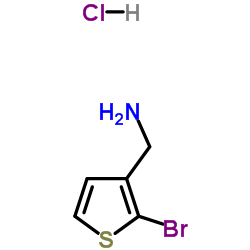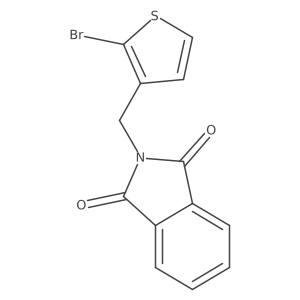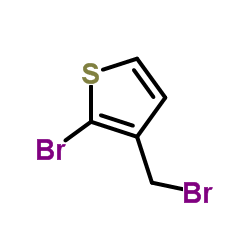157664-47-6
| Name | 3-(Aminomethyl)-2-bromothiophene |
|---|---|
| Synonyms |
1-(2-Bromo-3-thienyl)methanamine hydrochloride (1:1)
(2-bromothiophen-3-yl)methanamine,hydrochloride (2-Bromo-3-thienyl)methylamine 2-Bromo-3-thiophenemethylamine MFCD04971979 (2-BROMO-3-THIENYL)METHYLAMINE HYDROCHLORIDE 3-Thiophenemethanamine, 2-bromo-, hydrochloride (1:1) (2-Bromo-3-thienyl)methylamine,2-Bromo-3-thiophenemethylamine |
| Density | 1.669 |
|---|---|
| Boiling Point | 70ºC 0,01mm |
| Melting Point | 199ºC |
| Molecular Formula | C5H7BrClNS |
| Molecular Weight | 228.538 |
| Flash Point | 101.8ºC |
| Exact Mass | 226.917099 |
| PSA | 54.26000 |
| LogP | 3.47160 |
| Vapour Pressure | 0.03mmHg at 25°C |
Synonym:2-Bromo-3-methylaminothiophen Section 2 - COMPOSITION, INFORMATION ON INGREDIENTS
Risk Phrases: 20/21/22 34 Section 3 - HAZARDS IDENTIFICATION EMERGENCY OVERVIEW
Harmful by inhalation, in contact with skin and if swallowed. Causes burns.Air sensitive.Moisture sensitive. Potential Health Effects Eye: Causes eye burns. Skin: Harmful if absorbed through the skin. Causes skin burns. Ingestion: Harmful if swallowed. Causes gastrointestinal tract burns. Inhalation: Harmful if inhaled. Causes chemical burns to the respiratory tract. Chronic: Not available. Section 4 - FIRST AID MEASURES Eyes: Immediately flush eyes with plenty of water for at least 15 minutes, occasionally lifting the upper and lower eyelids. Get medical aid immediately. Skin: Get medical aid immediately. Immediately flush skin with plenty of water for at least 15 minutes while removing contaminated clothing and shoes. Ingestion: Do not induce vomiting. Get medical aid immediately. Inhalation: Get medical aid immediately. Remove from exposure and move to fresh air immediately. If not breathing, give artificial respiration. If breathing is difficult, give oxygen. Notes to Physician: Treat symptomatically and supportively. Section 5 - FIRE FIGHTING MEASURES General Information: As in any fire, wear a self-contained breathing apparatus in pressure-demand, MSHA/NIOSH (approved or equivalent), and full protective gear. Extinguishing Media: Use foam, dry chemical, or carbon dioxide. Section 6 - ACCIDENTAL RELEASE MEASURES General Information: Use proper personal protective equipment as indicated in Section 8. Spills/Leaks: Absorb spill with inert material (e.g. vermiculite, sand or earth), then place in suitable container. Section 7 - HANDLING and STORAGE Handling: Do not breathe dust, vapor, mist, or gas. Do not get in eyes, on skin, or on clothing. Use only in a chemical fume hood. Storage: Store in a cool, dry place. Store in a tightly closed container. Corrosives area. Store under nitrogen. Section 8 - EXPOSURE CONTROLS, PERSONAL PROTECTION Engineering Controls: Facilities storing or utilizing this material should be equipped with an eyewash facility and a safety shower. Use adequate ventilation to keep airborne concentrations low. Exposure Limits CAS# 157664-47-6: Personal Protective Equipment Eyes: Not available. Skin: Wear appropriate protective gloves to prevent skin exposure. Clothing: Wear appropriate protective clothing to prevent skin exposure. Respirators: Follow the OSHA respirator regulations found in 29 CFR 1910.134 or European Standard EN 149. Use a NIOSH/MSHA or European Standard EN 149 approved respirator if exposure limits are exceeded or if irritation or other symptoms are experienced. Section 9 - PHYSICAL AND CHEMICAL PROPERTIES Physical State: Viscous liquid Color: colorless Odor: Not available. pH: Not available. Vapor Pressure: Not available. Viscosity: Not available. Boiling Point: 70 deg C @0.01mmHg Freezing/Melting Point: Not available. Autoignition Temperature: Not available. Flash Point: Not available. Explosion Limits, lower: Not available. Explosion Limits, upper: Not available. Decomposition Temperature: Solubility in water: Specific Gravity/Density: Molecular Formula: C5H6BrNS Molecular Weight: 192 Section 10 - STABILITY AND REACTIVITY Chemical Stability: Not available. Conditions to Avoid: Incompatible materials, moisture, exposure to air, contact with water. Incompatibilities with Other Materials: Oxidizing agents, acids, acid chlorides. Hazardous Decomposition Products: Nitrogen oxides, carbon monoxide, oxides of sulfur, carbon dioxide, hydrogen bromide, ammonia, bromine. Hazardous Polymerization: Has not been reported Section 11 - TOXICOLOGICAL INFORMATION RTECS#: CAS# 157664-47-6 unlisted. LD50/LC50: Not available. Carcinogenicity: (2-Bromo-3-thienyl)methylamine - Not listed by ACGIH, IARC, or NTP. Section 12 - ECOLOGICAL INFORMATION Section 13 - DISPOSAL CONSIDERATIONS Dispose of in a manner consistent with federal, state, and local regulations. Section 14 - TRANSPORT INFORMATION IATA Shipping Name: CORROSIVE LIQUID, TOXIC, N.O.S.* Hazard Class: 8 (6.1) UN Number: 2922 Packing Group: III IMO Shipping Name: CORROSIVE LIQUID, TOXIC, N.O.S. Hazard Class: 8 (6.1) UN Number: 2922 Packing Group: III RID/ADR Shipping Name: CORROSIVE LIQUID, TOXIC, N.O.S. Hazard Class: 8 (6.1) UN Number: 2922 Packing group: III Section 15 - REGULATORY INFORMATION European/International Regulations European Labeling in Accordance with EC Directives Hazard Symbols: C Risk Phrases: R 20/21/22 Harmful by inhalation, in contact with skin and if swallowed. R 34 Causes burns. Safety Phrases: S 26 In case of contact with eyes, rinse immediately with plenty of water and seek medical advice. S 36/37/39 Wear suitable protective clothing, gloves and eye/face protection. S 45 In case of accident or if you feel unwell, seek medical advice immediately (show the label where possible). WGK (Water Danger/Protection) CAS# 157664-47-6: No information available. Canada None of the chemicals in this product are listed on the DSL/NDSL list. CAS# 157664-47-6 is not listed on Canada's Ingredient Disclosure List. US FEDERAL TSCA CAS# 157664-47-6 is not listed on the TSCA inventory. It is for research and development use only. SECTION 16 - ADDITIONAL INFORMATION N/A |
| Symbol |


GHS05, GHS06 |
|---|---|
| Signal Word | Danger |
| Hazard Statements | H301-H315-H318-H335 |
| Precautionary Statements | P261-P280-P301 + P310-P305 + P351 + P338 |
| Hazard Codes | Xi: Irritant;C: Corrosive; |
| Risk Phrases | R20/21/22;R34 |
| Safety Phrases | S26-S36/37/39-S45 |
| RIDADR | UN 2810 6.1 / PGIII |
| HS Code | 2934999090 |
|
~56% 
157664-47-6 |
| Literature: Finch, Harry; Reece, Donald H.; Sharp, John T. Journal of the Chemical Society, Perkin Transactions 1: Organic and Bio-Organic Chemistry (1972-1999), 1994 , # 9 p. 1193 - 1204 |
|
~% 
157664-47-6 |
| Literature: Journal of the Chemical Society, Perkin Transactions 1: Organic and Bio-Organic Chemistry (1972-1999), , # 9 p. 1193 - 1204 |
|
~% 
157664-47-6 |
| Literature: Journal of the Chemical Society, Perkin Transactions 1: Organic and Bio-Organic Chemistry (1972-1999), , # 9 p. 1193 - 1204 |
| Precursor 2 | |
|---|---|
| DownStream 0 | |
| HS Code | 2934999090 |
|---|---|
| Summary | 2934999090. other heterocyclic compounds. VAT:17.0%. Tax rebate rate:13.0%. . MFN tariff:6.5%. General tariff:20.0% |


